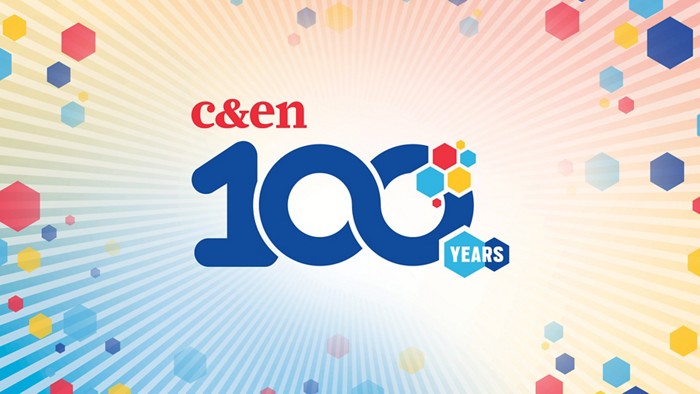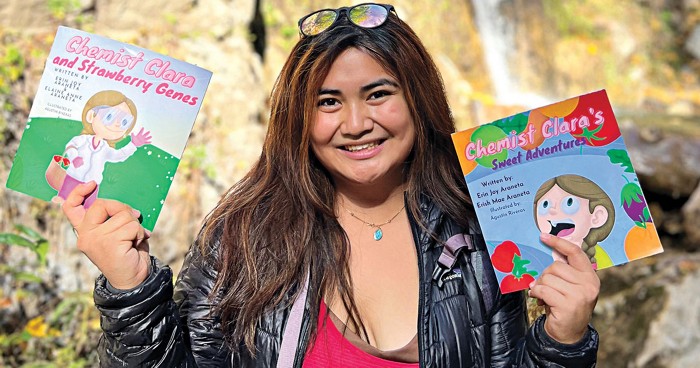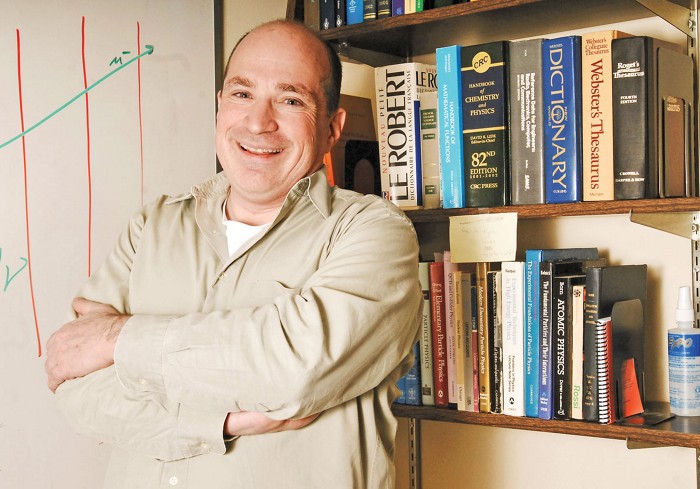Advertisement
Grab your lab coat. Let's get started
Welcome!
Welcome!
Create an account below to get 6 C&EN articles per month, receive newsletters and more - all free.
It seems this is your first time logging in online. Please enter the following information to continue.
As an ACS member you automatically get access to this site. All we need is few more details to create your reading experience.
Not you? Sign in with a different account.
Not you? Sign in with a different account.
ERROR 1
ERROR 1
ERROR 2
ERROR 2
ERROR 2
ERROR 2
ERROR 2
Password and Confirm password must match.
If you have an ACS member number, please enter it here so we can link this account to your membership. (optional)
ERROR 2
ACS values your privacy. By submitting your information, you are gaining access to C&EN and subscribing to our weekly newsletter. We use the information you provide to make your reading experience better, and we will never sell your data to third party members.
Science Communication
Podcast: Looking back on 100 years of chemistry
Reporter Alex Tullo shares a behind-the-scenes look at his special series highlighting stories from the C&EN archives
by Craig Bettenhausen , Brian Gutierrez, special to C&EN
September 29, 2023

The first issue of C&EN was published in 1923 with the stated purpose of “the promotion of research, the development of the chemical industry, and the welfare of the chemist.”
The world of chemistry has grown a lot since then, and the magazine has been there to report on it all.
To celebrate our 100th anniversary, C&EN reporter and informal historian Alex Tullo has sifted through thousands of issues of the magazine, and in this episode, he guides our host Craig Bettenhausen on a tour through the magazine’s history from the industrialization of plastics, to the environmental movement, to the modern era of digital publication.
When this episode was recorded, Tullo was preparing the From the Archives feature for the 1980s, which is now published.
C&EN Uncovered, a project from C&EN’s podcast,Stereo Chemistry, offers a deeper look at subjects from recent stories. Read Alex’s entire series about the C&EN archives at cenm.ag/fromthearchives.
Subscribe toStereo Chemistry now on Apple Podcasts, Spotify, or wherever you listen to podcasts.
Executive producer: Gina Vitale
C&EN Uncovered host: Craig Bettenhausen
Reporter: Alex Tullo
Audio editor: Brian Gutierrez
Copyeditor: Bran Vickers
Story editor: Manny I. Fox Morone
Episode artwork: Shutterstock/Kay Youn/Will Ludwig/C&EN
Music: “Hot Chocolate” by Aves
Contact Stereo Chemistry: Contact us on social media at @cenmag or email cenfeedback@acs.org.
The following is a transcript of the episode. Interviews have been edited for length and clarity.< /p>
Craig Bettenhausen: Welcome to C&EN Uncovered. I’m Craig Bettenhausen. C&EN Uncovered is a podcast project fromStereo Chemistry. In each episode, we’ll take another look at a recent story in Chemical & Engineering News and hear from C&EN reporters about striking moments from their reporting, their biggest takeaways, and what got left on the cutting-room floor. Now normally on Uncovered, we dive deeper into a cover story, but in this episode, we’re looking at a whole series called From the Archives that senior editor Alex Tullo has been working on all year as part of C&EN’s centennial celebrations. Hi, Alex.
Alex Tullo: How’re you doing?
Craig: Good. So Alex, to start off, for anyone that’s missed these articles, can you give a brief intro into what you’ve been doing with this series?
Alex: So the series began earlier this year, and every month we have been profiling an article from our 100 years. So each month we’ve taken on a new decade, and so we highlight an article, and I write a little text to contextualize it.
Craig: So you’ve become C&EN’s resident historian in some ways. And I wonder if you could give our listeners like a quick origin story for C&EN. Where did C&EN come from?
Alex: So this was back in 1923. It was a time when chemistry and formal chemistry, proper chemistry, was having a big impact on society. It wasn’t too long after Leo Baekeland came out with Bakelite.
Craig: So it’s like the first polymers, right?
Alex: The first plastic, right? The first industrialized synthetic plastic. It wasn’t too long after Bayer came out with Aspirin. So you can just kind of imagine the time where chemistry is sort of making these gains and really changing how people lived, right? It was kind of the golden years, right, of chemistry. So they needed a voice. So that’s really how the magazine began, and that’s how it was for the first decade.
Our very first issue actually, you know, gives them a mission statement: “Its purpose is the promotion of research,” and “development of the chemical industry, and the welfare of the chemist. We shall strive to further these objects by rendering a service for which we believe there is a demand not now met in any publication.”
Craig: So when I tell nonchemists what I do, and especially when I say the name of our magazine today, they’re usually guessing that we’re a trade rag or a member magazine or an academic journal. I usually tell them that we’re a specialist newsmagazine. In the context of your historical explorations, what do you think of as the essential character of Chemical & Engineering News as you see it today? And you started to talk about this a little bit, but how has that changed over the course of the magazine’s publication?
Alex: Right, so a big theme throughout our history is that impact-on-society question. So whether it is those early days of commercialization of products or increasingly over the years, it got into more formal chemistry coverage. Environmentalism came to the fore in the 1960s or so, and it’s still an element of the coverage today. When did we emerge as a magazine? Like, when do we become recognizable as a magazine the way people would recognize the magazine today? That happens in the 1940s.
Craig: OK. So there have been, at this point, thousands of issues of C&EN. You’ve been pulling out one article to write up for each decade. That’s still a massive amount of options. How do you narrow it down? How do you pick one article among a whole decade of coverage?
Alex: So if you have a basic idea that something happened at a certain time, you can rest assured that C&EN covered it one way or another. Very rarely do I stump the magazine. Even if something had just minimal potential, we tended to kind of write about it. Finding things for the magazine, from the magazine, I would say that I just have an idea of “Something happened at a certain period of time. How did we cover it?” And I usually find pretty interesting stuff.
One feature that we did have in the past that we haven’t had in my tenure really is guest editorials. There was a lot of that in the 1940s, ’50s, ’60s.
Craig: And so were these written by ACS staff and executives? Were these written by somebody from DuPont or a professor from Berkeley? Like who was writing these?
Alex: Well, the last—precisely those last two examples. So Glenn Seaborg wrote things for C&EN about heavy elements and stuff like that. And Irving Langmuir wrote in, I think in 1945, he went on a trip to Russia and wrote a multipage article on that. Waldo Semon, who was a scientist for B.F. Goodrich, credited usually with inventing PVC or making it a commercial product, he did one on history of development before the war, during the war, on rubber and so on.
Craig: So looking through a hundred years of coverage, like you said, you’ve come across some stuff that we maybe treated as minor, but it turned out to be almost prophetic. Can you tell me a little bit about that? What are some of the standouts that we covered as if they were just a small thing that turned out to be a big deal?
Alex: Right, so the most recent From the Archives talks about—it was a new product that Dupont had put out. They called it “Fiber B.” It was for tire cord. Make better tire cords.
Craig: Sure, yeah, it does.
Alex: To replace steel in steel-belted radial tires was the intention for this product, which was a big market at the time. It was a big R&D effort at Dupont at the time. As it turned out, that wasn’t the only market for it. A few years after they introduced Fiber B product under this code name, they renamed it, rebranded it, as Kevlar.
[I’ve been] covering polymer chemistry for about 25 years. Never realized that Kevlar was going by some other name. We wrote this announcement in just one little paragraph Concentrate at the time. This was in 1970, like I said, just for tire applications with absolutely no acknowledgment of what would come after, because that was a market that wasn’t developed until, you know, the late 1970s or early 1980s for, you know, bulletproof vests and so on and so forth. So it became a hit that DuPont really didn’t know it had a hit on its hands. So that was really the intriguing thing to me, that they just thought it would be good for tire cord and stuff like that.
Craig: Now, I’m naturally inclined to be pro-C&EN. I was a fan before I was a staffer, and I’ve been a staffer for like 12 years now. But what are some examples, sometimes when we were, we covered it, but we were on the wrong side of history?
Alex: The most startling example is from the early ’60s, which was the book review of Silent Spring by Rachel Carson. So Silent Spring was about the contamination of insecticides in the environment, such as DDT.
Craig: DDT, this pesticide, this really effective mosquito killer, was also doing terrible things to the reproductive cycle of birds, especially the eagles, was the prime example. The book was about a lot more than that, if I remember right, but that’s the one that jumps to mind for a lot of people.
Alex: It became a touchstone, and I like to say a foundational document, for the environmental movement itself. It was the first time people really realized that chemistry can have a deleterious effect on the environment. So it was really a wake-up call for chemistry and industry.
So when the book came out, we ran a book review, and it was titled “Silence, Miss Carson,” which is an unfortunately patriarchal and dismissive title that we put on it. So we ran this review, which gave a broadside against the book in every possible way. It was written by a chemistry professor at Vanderbilt University, I think it was. And this professor accuses Carson of cherry-picking information, making emotional appeals, misinterpreting data, and all that sort of stuff. So it’s just—nitpicked the book and really told people not to read it. It was a very dismissive piece of work. That said, within a couple weeks there were letters written in response to that review that were complimentary towards the book, so we ran those letters as well. Unfortunately, at the time, C&EN kind of missed it and pushed back on it when it first came out.
Craig: Yeah, I think it’s interesting. I mean, the magazine’s been around for so long. We’re bound to get some things wrong. And I’m sure, I mean, I’m writing about controversial things now. I’m about to do nuclear power. I’m sure we’ll get letters about that. I’m writing about carbon capture, and we have gotten plenty of letters about that. But it’s important to acknowledge we want to be wrong as infrequently as possible. So it’s good to learn from them too.
So looking back over the history as we are, I can’t help but reflect on the future of the magazine. As you’ve been going through these archives, what lessons have you gleaned that inform how you’re thinking about the magazine as it rebuilds and reimagines itself for the next 100 years?
Alex: A few things. So it is comforting to see that the magazine has survived as long as it has, right? Through a Great Depression, through a world war, through the Cold War, through everything else. So that in and of itself is comforting, that chemists have thought we were valuable enough to keep us around for 100 years. We were always experimenting. If we keep on doing that, we’ll be in good shape, I think, in the future.
Advertisement
Craig: Yeah, I remember when I started in the magazine, I was in the production department, and one of the former production editors, Dave Hanson, had written a history, and he would regale the production editors who were on the same hall with tales of how the magazine used to be done. I mean, I came in when we really digitized everything kind of fully. But when he was a production editor, they would finish the magazine, and it was like a physical object that he or another person would then drive to Pennsylvania to be made into a print, put on the presses and things like that. So it’s changed a lot in how it’s done, even if it’s kind of the same thing in some ways.
Alex: So I started in 1999. When I started, the only change like that I really remember was, galleys would get faxed back and forth.
Craig: Alex, I’ve been excited to read these articles, and I’m excited that we get to keep reading it because you’re going to be still working on this project for at least through the end of this year, right?
Alex: Absolutely. In fact, the next edition will be the 1980s, and of course it will be on the Bhopal disaster of 1984. That was a methyl isocyanate leak at a Union Carbide plant in India. It killed thousands of people, and it had far-reaching effects on the chemical industry and chemical safety and so on and so forth.
Craig: That incident for one thing destroyed Union Carbide pretty much, right? I mean, after that, it struggled and then was sold off for parts.
Alex: From a financial standpoint. Yeah, it beat down Union Carbide quite a bit. The Bhopal disaster was also, you know, been a diplomatic problem between the United States and India. I mean, there were just so many far-reaching effects of this event. Was probably the most important single event really in the history of the chemical industry.
Craig: So we can look forward to that. Maybe a more dour one than others, but important for sure.
Well, Alex, thank you for taking the time today and for being C&EN’s unofficial-official resident historian. If people want to find you on social media, what’s your handle?
Alex:@ AlexTullo—
Craig: Easy enough.
Alex: —On Twitter. Or X. X!
Craig: And you can find me on Twitter or X or whatever you want to call it. On most platforms, I’m @CraigofWaffles. Once again, you can find Alex’s From the Archives series on our website, in the C&EN centennial collection, or once a month in the print edition of C&EN. We’ve put a link in the show notes, along with the episode credits.
And we’d love to know what you think of C&EN Uncovered. You can share your feedback with us by emailing cenfeedback@acs.org. This has been C&EN Uncovered, a series from C&EN’s Stereo Chemistry.
Stereo Chemistry is the official podcast ofChemical & Engineering News. C&EN is an independent news outlet published by the American Chemical Society. Thanks for listening.





Join the conversation
Contact the reporter
Submit a Letter to the Editor for publication
Engage with us on Twitter